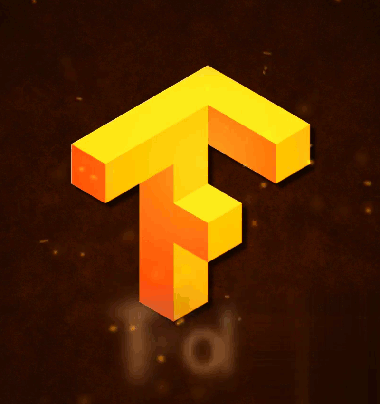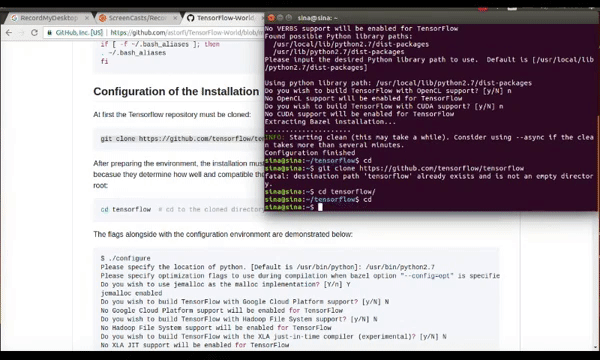This repository is aimed to provide simple and ready-to-use tutorials for TensorFlow. The explanations are present in the wiki associated with this repository. Each tutorial has a source code and its documentation.
There are different motivations for this open source project. TensorFlow is one of the best deep learning frameworks up to the moment that this document is being written! The question is why this repository has been created among all other available tutorials on TensorFlow on the web?
A deep learning is of great interest these days, the crucial necessity for rapid and optimized implementation of the algorithms and designing architectures is the software environment. TensorFlow is designed to facilitate this goal. The strong advantage of TensorFlow is it flexibility is designing highly modular model which also can be a disadvantage too for beginners since lots of the pieces must be considered together for creating the model. This issue has been facilitated as well by developing high-level APIs such as Keras and Slim which gather lots of the design puzzle pieces. The interesting point about TensorFlow is that its trace can be found anywhere these days. Lots of the researchers and developers are using it and its community is growing with the speed of light! So the possible issues can be overcame easily since they might be the issues of lots of other people considering a large number of people involved in TensorFlow community.
Developing open source project for the sake of just developing something is not the reason behind for this effort. Considering the large number of tutorials that are being added to this large community, this repository has been created to break the jump-in and jump-out process usually happens to most of the open source projects, but why and how?
First of all, what's the point of putting effort on something that most of the people won't stop by and take a look? What's the point of creating something that does not help anyone in the developers and researchers community? Why spending time for something that can easily be forgotten? But how we try to do it? Even up to this very moment there are countless tutorials on TensorFlow whether on the model design or TensorFlow workflow. Most of them are too complicated or suffer from a lack of documentation. There are only a few available tutorials which are concise and well-structured and provide enough insight for their specific implemented models. The goal of this project is to help the community with structured tutorials and simple and optimized code implementation to provide better insight about how to use TensorFlow fast and efficient. It is worth noting that, the main goal of this project is providing well-documented tutorials and less-complicated codes!
The tutorials in this repository are partitioned into relevant categories.
| # | topic | Source Code | |
|---|---|---|---|
| 1 | Start-up | ||
| 2 | TensorFLow Basics | ||
| 3 | TensorFLow Basics | TensorFlow Variables / IPython | |
| 4 | Machine Learning | Linear Regression / IPython | |
| 5 | Machine Learning | Logistic Regression / IPython | |
| 6 | Machine Learning | Linear SVM / IPython | |
| 7 | Machine Learning | MultiClass Kernel SVM / IPython | |
| 8 | Neural Networks | Multi Layer Perceptron / IPython | |
| 9 | Neural Networks | Convolutional Neural Networks | |
| 10 | Neural Networks | Undercomplete Autoencoder |
In order to install TensorFlow please refer to the following link:
The virtual environment installation is recommended in order to prevent package conflict and having the capacity to customize the working environment. The TensorFlow version employed for these tutorials is 1.1. However, the files from previous versions can be transformed to newer versions (ex: version 1.1) using the instructions available in the following link:
- TensorFlow Examples - TensorFlow tutorials and code examples for beginners
- Sungjoon's TensorFlow-101 - TensorFlow tutorials written in Python with Jupyter Notebook
- Terry Um’s TensorFlow Exercises - Re-create the codes from other TensorFlow examples
- Classification on time series - Recurrent Neural Network classification in TensorFlow with LSTM on cellphone sensor data
When contributing to this repository, please first discuss the change you wish to make via issue, email, or any other method with the owners of this repository before making a change. For typos, please do not create a pull request. Instead, declare them in issues or email the repository owner.
Please note we have a code of conduct, please follow it in all your interactions with the project.
Please consider the following criterions in order to help us in a better way:
- The pull request is mainly expected to be a code script suggestion or improvement.
- A pull request related to non-code-script sections is expected to make a significant difference in the documentation. Otherwise, it is expected to be announced in the issues section.
- Ensure any install or build dependencies are removed before the end of the layer when doing a build and creating a pull request.
- Add comments with details of changes to the interface, this includes new environment variables, exposed ports, useful file locations and container parameters.
- You may merge the Pull Request in once you have the sign-off of at least one other developer, or if you do not have permission to do that, you may request the owner to merge it for you if you believe all checks are passed.
We are looking forward to your kind feedback. Please help us to improve this open source project and make our work better. For contribution, please create a pull request and we will investigate it promptly. Once again, we appreciate your kind feedback and elaborate code inspections.


